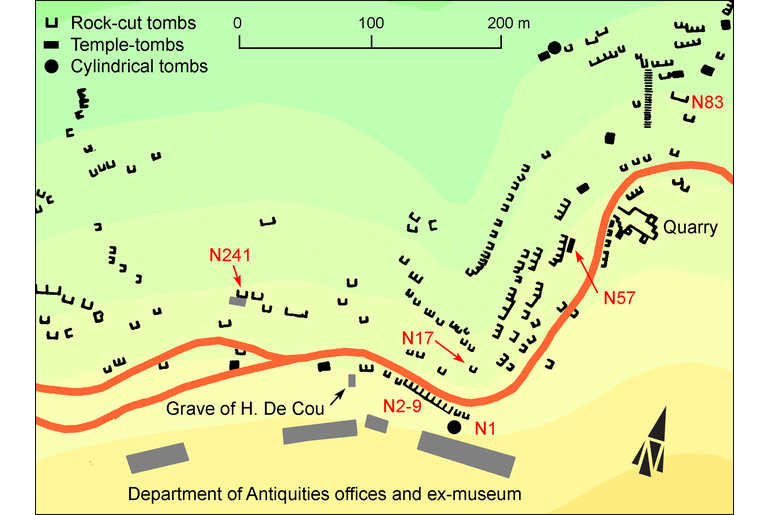Epitaph
IGCyr118710
Trismegistos ID: 738736
Source Description
Support
Limestone sarcophagus with double slope lid surmounted by a platform for a half-statue (wide 1.0; long 2.3).
Layout
Inscribed on the Northern part of the Eastern slope of the lid, in two lines.
Letters
Unknown; slantering mu and sigma; upsilon with tall tail.
Place of Origin
Findspot.
Date
Perhaps fourth century B.C. (lettering, context)
Findspot
Found between 1955 and 1957 by A. Rowe at Cyrene pleiades; HGL : North Necropolis , sarcophagus N 81.AA.
Present Location
Not found by IGCyr team.
Text constituted from
Transcription from editor and photograph (CDL).
Bibliography
Rowe, 1959 Rowe, A., 1959, in A. Rowe, J.F. Healy (eds.), Cyrenaican Expeditions of the University of Manchester 1955, 1956, 1957; comprising an account of the excavated areas of the cemeteries at Cyrene and of objects found in 1952 by Alan Rowe, M.A. together with descriptions of the coins by John F. Healy, M.A., Ph.D., F.R.N.S., Manchester, 1-29 - see in bibliography , p. 8 and pl. 21 (photo). Cf. Fraser-Matthews, 1987 Fraser, P.M., Matthews, E. (eds.), 1987, Lexicon of Greek Personal Names, I: The Aegean Islands, Cyprus, Cyrenaica, Oxford - see in bibliography , p. 269.
Apparatus
French translation
Lysis fils de Lysis. Komôn fils de Komôn.
English translation
Lysis son of Lysis. Komon son of Komon.
Italian translation
Lysis figlio di Lysis. Komon figlio di Komon.
Arabic translation
ليسيس بن ليسيس. كومون بن كومون.
Commentary
Rowe was only able to give a copy in block-letters. Although the reading is not quite easy to check from the photograph, the sequence may be interpreted, supposing that ΙΣ was cut twice. Those surplus letters at line 1 and the oblique stroke at the end of each line prevented Rowe from offering an interpretation. Whereas the mention of the two Komon at line 2 was registered by Fraser-Matthews, 1987 Fraser, P.M., Matthews, E. (eds.), 1987, Lexicon of Greek Personal Names, I: The Aegean Islands, Cyprus, Cyrenaica, Oxford - see in bibliography (obviously on J.M. Reynolds' advice), the two Lysis were not.
This instance of the oblique stroke for abbreviating a father's name identical with the son's one is probably the most ancient one. For another instance of Hellenistic age, see IGCyr033100, a.I.10 and b.161. There are more occurrences in the Roman period
Creative Commons Attributions-NonCommercial 4.0 International License.
All citation, reuse or distribution of this work must contain a link back to DOI: http://doi.org/10.6092/UNIBO/IGCYRGVCYR and the filename (IGCyr000000 or GVCyr000), as well as the year of consultation.
